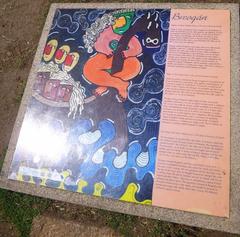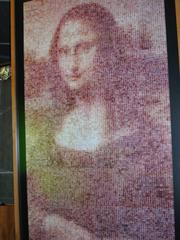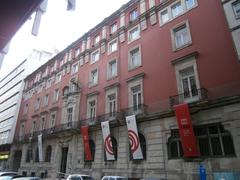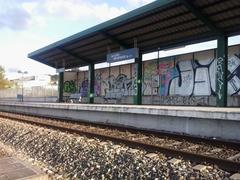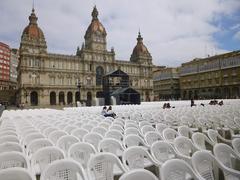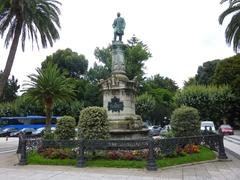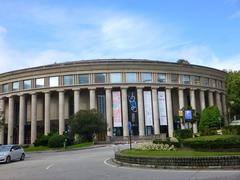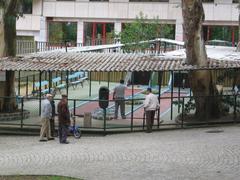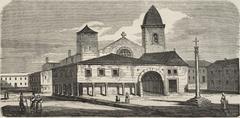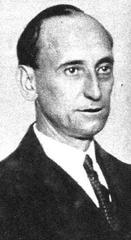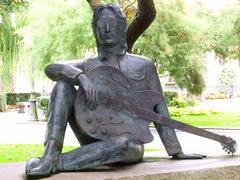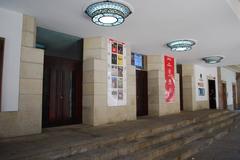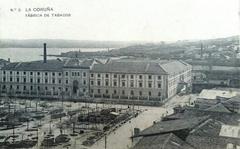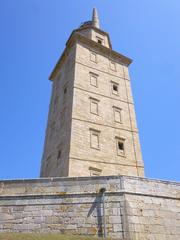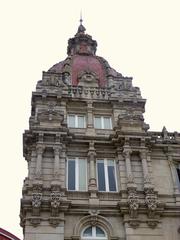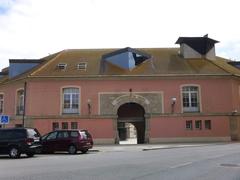
Archivo del Reino de Galicia: Comprehensive Visiting Guide for A Coruña
Date: 03/07/2025
Introduction: Why Visit the Archivo del Reino de Galicia?
Located in A Coruña’s historic Ciudad Vieja, the Archivo del Reino de Galicia is one of Spain’s most significant archival institutions. Established in 1775 by royal decree, the archive centralizes and safeguards over a millennium of judicial, administrative, ecclesiastical, and private documents that chronicle the evolution of Galicia. Both a provincial and regional archive, it is an essential destination for researchers, genealogists, students, and cultural travelers seeking to explore the region’s complex identity and historical legacy (VisitCoruña).
The archive’s location beside the scenic Jardines de San Carlos—near other landmarks like Casa Museo Emilia Pardo Bazán and Castelo de San Antón—makes it an ideal starting point for exploring A Coruña historical sites. Admission is free, and the institution offers a wide array of public services, including guided tours, workshops, and document consultation.
For up-to-date visitor details, consult the official Arquivo de Galicia portal.
Historical Overview: Origins and Institutional Evolution
Foundation and Early Mandate
The Archivo del Reino de Galicia was created by the Real Cédula of King Charles III in 1775, building on legal precedents from the 16th century that mandated the preservation of judicial records from the Real Audiencia de Galicia, which itself dates to 1480. The archive’s original mission was to centralize, preserve, and facilitate access to the records of Galicia’s principal judicial and governing body (Wikipedia).
Relocations and Headquarters
- 1775: Established in the Palacio de la Real Audiencia (now Capitanía General).
- 1936: Moved to the Palacio de Justicia’s basements.
- 1955: Inauguration of the current headquarters, designed by Antonio Tenreiro Rodríguez. The building, with four floors and three interconnected blocks, lies within the Jardines de San Carlos, beside the tomb of Sir John Moore.
- 1962: Institution renamed Archivo Histórico del Reino de Galicia.
- 1985: Declared a Bien de Interés Cultural, recognizing its architectural and historical value.
Since 1989, the archive has been managed by the Xunta de Galicia, solidifying its status as a regional cultural institution (La Voz de Galicia).
Archive Collections: Scope and Research Value
The Archivo del Reino de Galicia preserves over 17 linear kilometers of documentation, including:
- Judicial Documents: Real Audiencia de Galicia records from the late Middle Ages onward.
- Notarial and Ecclesiastical Archives: Wills, contracts, parish records, and diocesan files.
- Municipal and Provincial Records: Administrative, fiscal, and governance documents.
- Private & Family Papers: Donated by prominent Galician families.
- Cartography, Photographs, and Ephemera: Maps, photographs, postcards, and public health documents (including those related to leprosy campaigns) (Leprosy History).
Researchers, genealogists, and historians can access finding aids, inventories, and selected digitized materials online via the Galiciana portal.
Visitor Information: Hours, Tickets, Facilities, and Accessibility
Standard Visiting Hours
- Winter (September–June): Monday to Friday, 8:30 a.m.–8:30 p.m.
- Summer (June–September): Monday to Friday, 8:30 a.m.–7:30 p.m.
- Closed: Weekends and public holidays (whichmuseum.com)
Note: Alternative sources may show slight variations. Always check the official site before planning your visit.
Admission and Booking
- Entry: Free for all visitors.
- Guided Tours: Offered regularly, especially during events like International Archives Day. Advance registration required.
- Workshops: Practical sessions on paleography, genealogical research, and document preservation can be booked through the archive or affiliated civic centers (coruna.gal).
Facilities and Accessibility
- Accessibility: The building is equipped with ramps and elevators for visitors with reduced mobility.
- Document Access: On-site consultation of original documents and microfilms; reprography services available within conservation guidelines.
- ID Required: DNI or passport for document access.
- Amenities: Basic facilities are available; inquire directly for details.
Location
- Address: Jardín de San Carlos 1, s/n, 15003 A Coruña, Spain
- Transport: Well-served by public buses and city taxis. Parking is limited in the city center; public transport or walking from nearby attractions is recommended.
Visitor Experience: Tours, Educational Activities, and Research Support
- Guided Tours: Explore the history, collections, and research methods of the archive. Tours are available for schools, universities, and the general public and adapt to various knowledge levels.
- Workshops: Hands-on training in archival research and document handling.
- Exhibitions: Temporary displays highlight treasures from the archive, including medieval manuscripts and rare photographs.
- Digital Resources: Extensive online catalogs and digitized documents for remote research (Arquivo de Galicia Official Site).
Nearby Attractions and Itinerary Suggestions
Combine your visit with other A Coruña highlights:
- Casa Museo Emilia Pardo Bazán
- Casa Museo María Pita
- Castelo de San Antón
- MEGA - Mundo Estrella Galicia
- Domus Museum
- National Museum of Science and Technology
- Jardín de San Carlos (directly adjacent)
FAQ: Essential Visitor Questions
Is there an admission fee?
No, entry is free for all visitors.
What are the visiting hours?
Monday to Friday, 8:30 a.m.–8:30 p.m. (winter); 8:30 a.m.–7:30 p.m. (summer). Closed weekends and public holidays.
Are guided tours available?
Yes; book in advance via the official website or by phone.
Is the building accessible?
Yes, with ramps and elevators for visitors with reduced mobility.
Can I take photographs?
Photography of documents may be restricted; please ask staff before taking photos.
Do I need ID to access documents?
Yes, bring a DNI or passport.
How do I get there by public transport?
Several local buses stop near Jardín de San Carlos. The location is within walking distance from the city center.
Summary: Key Points for Visitors
- Significance: The archive preserves Galicia’s most important documents, spanning judicial, ecclesiastical, municipal, and private collections.
- Location: Centrally situated in A Coruña’s Ciudad Vieja, beside major attractions.
- Admission: Always free.
- Facilities: Accessible, with public consultation rooms, workshops, and online resources.
- Experience: Suitable for researchers, students, and tourists alike.
- Enrichment: Combine your visit with nearby museums and historical sites for a full cultural itinerary.
For the most up-to-date details on visiting hours, tours, and accessibility, check the official website.
Visuals and Internal Links Suggestions
- Use web-optimized images of the archive building, Jardín de San Carlos, and archival documents with descriptive alt tags (e.g., “Archivo del Reino de Galicia visiting hours,” “A Coruña historical sites”).
- Embed an interactive map showing the archive’s location and proximity to other attractions.
- Include internal links to related articles on A Coruña museums, Galician history, or travel itineraries.
Sources
- Complete Guide to Visiting the Archivo del Reino de Galicia: Hours, Tickets, and Historical Insights, 2025, VisitCoruña (VisitCoruña)
- Archivo del Reino de Galicia: Visiting Hours, Tickets, and Historical Significance in A Coruña, 2025, La Voz de Galicia (La Voz de Galicia)
- Visitor Experience and Facilities, 2025, WhichMuseum (whichmuseum.com)
- Visiting the Archivo del Reino de Galicia: Hours, Tickets, Educational Tours, and Historical Highlights, 2025, Arquivo de Galicia Official Site (Arquivo de Galicia Official Site)
- Archivo del Reino de Galicia Wikipedia, 2025 (Wikipedia)
- Leprosy History Archive, 2025 (Leprosy History)
- Paxinas Galegas, 2025 (Paxinas Galegas)




